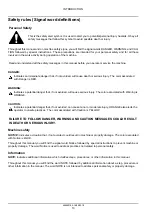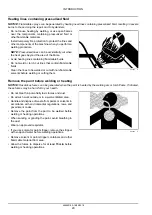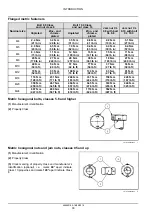
INTRODUCTION
Safety rules
Health and safety precautions
Many of the procedures involved in machine maintenance and repair services involve physical hazards and other
health risks. This section lists some of these hazardous procedures and the materials and equipment associated with
them.
Acids and alkalis
Avoid splashing into your eyes and nose, or onto your skin and clothing. Wear suitable sleeves and protective goggles.
Irritate and corrode the skin, eyes, nose, and throat. Causes burns. Do not inhale the fumes.
Adhesives and sealants
These are highly flammable. You must store them in no smoking areas. Use applicators when possible or secondary
containers. The containers must be labeled.
Resin-based adhesives/sealants
Skin contact could result in irritation, dermatitis, and the absorption of toxic or harmful chemicals through the skin.
Splashes could cause eye injuries. Ensure that there is adequate ventilation and avoid contact with the skin and the
eyes. Follow the manufacturer’s instructions.
Ensure that there is adequate ventilation as volatile harmful or toxic chemicals may be released.
Anti-freeze
These are highly flammable. You must store them in no smoking areas.
Anti-freeze can be absorbed through the skin in toxic or harmful quantities. Ingesting anti-freeze can cause death
and you must seek medical assistance immediately.
Chemicals – General
You must always take care when using and handling chemicals such as solvents, sealants, adhesives, paints, foam
resins, battery acids, anti-freeze, brake fluid, oils and greases. They may be harmful, toxic, corrosive, irritant, or highly
flammable. They may also emit hazardous fumes or dust.
Do
Remove chemicals from skin and clothing as soon as possible after contact. Change very dirty clothes and make
provision for cleaning them.
Read and strictly adhere to the safety recommendations on the chemical containers.
When working with chemicals, wash before breaks, and before eating, smoking, drinking, or using the bathroom.
Keep work areas clean, organized, and free of spillages. Store according to local and national legislation. Keep
chemicals out of the reach of children.
Do not
Do not mix chemicals, except in accordance with the manufacturer's instructions. Some substances could form other
chemical substances that are toxic or harmful, emit toxic or harmful fumes, or become explosive after mixing. Do not
spray chemicals, especially solvent-based chemicals, in enclosed spaces.
Do not apply heat or flames to chemicals, except in accordance with the manufacturer's instructions. Some are highly
flammable or could release toxic or harmful fumes.
Do not leave containers open. The fumes emitted could accumulate in toxic, harmful, or explosive concentrations.
Some fumes are heavier than air and will accumulate in confined areas, trenches, etc. Do not put chemicals in un-
marked containers.
48096018A 18/05/2018
15



































